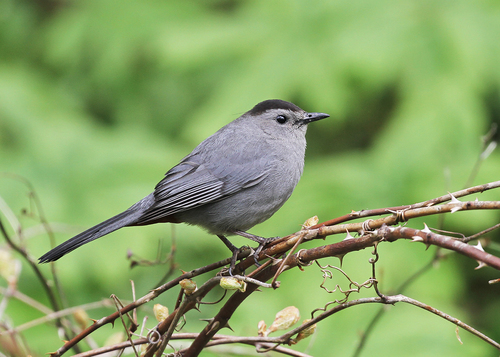
Grey Catbird
The Grey Catbird (Dumetella carolinensis) is a medium-sized perching bird known for its distinctive cat-like mewing call, which gives it its common name. It's a member of the Mimidae family, which also includes mockingbirds and thrashers, and shares their talent for vocal mimicry, though to a lesser extent. This adaptable bird plays an important role in seed dispersal and insect control within its range. While not particularly flashy in appearance, its secretive nature and unique vocalizations make it a fascinating subject for birdwatchers.
20.5-24 cm
Length
22-30 cm
Wingspan
Least Concern
Conservation Status
Distribution
The Grey Catbird breeds across much of North America, from southern Canada (British Columbia to Nova Scotia) south to the central and eastern United States, reaching as far south as northern Texas and Florida. During winter, it migrates to the southeastern US, Mexico, Central America, and the Caribbean.
Lifespan
Up to 10 years in the wild; records of over 17 years in captivity exist, but are rare.
Grey Catbird's Habitat
Habitat Types
Dense thickets, Shrublands, Woodland edges, Overgrown fields, Suburban gardens
Climate Zones
Temperate, Subtropical
Adaptations
Grey Catbirds prefer dense, low-lying vegetation, which provides cover for nesting and foraging. Their slender bodies and relatively short, rounded wings are well-suited for maneuvering through tangled undergrowth.
Variations
While generally considered monotypic (no recognized subspecies), some slight regional variations in size and plumage darkness have been observed, but these are not considered distinct enough to warrant subspecies classification.
Appearance
Breeding Plumage
Plumage remains relatively consistent year-round.
Seasonal Feather Changes
Minimal seasonal variation; may appear slightly duller in winter due to feather wear.
Sex Based Plumage Differences
Males and females have very similar plumage.
Notable Features
Slate-grey overall plumage, Black cap, Black tail, Rufous (reddish-brown) undertail coverts
Diet and Feeding
Primary Foods
Insects, Spiders, Fruits, Berries
Foraging Behavior
Grey Catbirds primarily forage on or near the ground, gleaning insects and fruits from foliage and leaf litter. They often hop and flit through dense vegetation, probing and searching for prey.
Specializations
Their slightly downcurved bill is well-suited for probing into crevices and turning over leaves to find insects. They also have a strong gizzard that helps them process the seeds of fruits.
Seasonal Diet Variations
During the breeding season, their diet is primarily insects and other invertebrates. In the fall and winter, they shift to a diet richer in fruits and berries, which provide essential energy for migration and overwintering.
Behavior
Social Structure
Generally solitary or found in pairs during the breeding season. May form small, loose flocks during migration and in winter.
Communication
Cat-like "mew" call, Complex songs incorporating mimicry of other bird species, Chattering and scolding calls, Whisper songs
Migration
Grey Catbirds are short- to medium-distance migrants. They migrate at night, often in loose flocks. Navigation is thought to involve a combination of celestial cues, the Earth's magnetic field, and visual landmarks.
Territorial or Group Behaviors
Males are highly territorial during the breeding season, defending their territory against other males through song and aggressive displays. They are known to be aggressive towards other species, and have been observed destroying eggs of other birds.
Conservation
Threats
Habitat loss and fragmentation due to urbanization and agriculture, Pesticide use, which reduces insect prey availability, Collisions with buildings and windows, Predation by domestic cats
Protection Programs
General habitat conservation efforts, Promoting bird-friendly landscaping practices, Efforts to reduce pesticide use
Local National Laws
Protected under the Migratory Bird Treaty Act in the United States.
Population Trend
Stable
Population Estimates
Global population estimated to be around 29 million.
Interesting Facts
Grey Catbirds are skilled vocal mimics.
Although not as proficient as Northern Mockingbirds, they can incorporate the songs and calls of other birds into their own repertoire.
They are known to destroy the eggs of other bird species.
This behavior, known as heterospecific ovicide, is thought to reduce competition for resources, although the exact reasons are not fully understood.
They recognize and eject Brown-headed Cowbird eggs
Brown-headed Cowbirds are brood parasites, and catbirds have developed the ability to identify and remove their eggs from their nests, a behavior not all host species exhibit.
Faqs about Grey Catbird
What does a Grey Catbird sound like?
The most characteristic call is a cat-like "mew," but they also have a complex song that can include imitations of other birds.
Are Grey Catbirds aggressive?
Males can be aggressive during the breeding season, defending their territories vigorously. They are also known to destroy the eggs of other birds.
Do Grey Catbirds migrate?
Yes, they are short- to medium-distance migrants, moving south for the winter to the southeastern US, Mexico, Central America, and the Caribbean.
What do Grey Catbirds eat?
They eat a mix of insects, spiders, fruits, and berries. Their diet shifts seasonally, with more insects during breeding and more fruits in fall and winter.
Copyright @ Nature Style Limited. All Rights Reserved.
 English
English